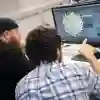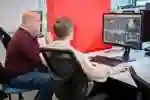



We’ll teach you how to create visual solutions for specific audiences and purposes. Giving you a competitive edge when it’s time to enter the job market.
Explore the very heart of graphic design — understanding audiences and how to create effective and suitable messages using text and imagery. Then develop the ability to construct conceptual graphic design solutions that stimulate desired responses.
You’ll create your designs working within industry-standard media labs. And work on a professional portfolio throughout your degree so you can showcase your skills to potential employers.
About this course
Gain the technical, critical, business and personal skills to succeed in the creative industries. This degree blends hands-on skill with thought-provoking theory, preparing you for a broad range of careers.
Study advanced visual design, creative thinking, typography, the use of colour and composition as well as design history. Construct conceptual graphic design solutions that stimulate desired responses. Then learn how to create graphics using traditional techniques and the latest digital technologies, working with 2D and 3D design, web applications, animation and other evolving media.
As well as technical skills you'll develop knowledge in leadership and design practice, working as professionals do in a studio environment. And you’ll work towards a major project in your final year, developing a professional portfolio to showcase your capabilities and specialisms.
Play your part in tomorrow's world today
Module options
Filters
Practical Skills for Graphic Design: Adobe 2D
This 20-credit practical skills module will introduce you to basic graphic design software packages. Weekly lectures and workshops will teach you how to solve visual design exercises using both vector and bitmap art. Graphic Design students will apply these skills in the concurrently running 2D Visual Design module.
compulsory
20 credits
Graphic Design Essentials: 2D Visual Design
As in all of your 40-credit modules, this intense design class aims to parallel industry practice. Assignments will include the basic exploration of conceptual design, typography, colour theory, visual composition and photo editing—all presented within the context of design history.
compulsory
40 credits
Practical Skills for Graphic Design: Adobe Web
This module will provide you with the critical skills required to learn basic web software packages, and you will be encouraged to learn associated packages as well. You will develop a commitment to the process of ongoing skills development essential for long-term career goals.
compulsory
20 credits
Graphic Design Essentials: UI & UX Design
This module introduces you to User Interface (UI) and User Experience (UX) design theory, and provides a gateway to the constantly evolving world of graphic design for the web. Assignments will focus on design process, design theory, scenarios, testing, evaluation, contemporary trends and future innovations.
compulsory
40 credits
Practical Skills for Art Direction: Web Technologies
This exercised-based skills module will teach you to develop responsive web design layouts. You will develop initial design ideas into industry standard graphic design solutions, including a wide range of media content and interactive elements.
compulsory
20 credits
Practical Skills for Art Direction: The Moving Image
This software instruction module focuses on 2D animation, basic 3D modelling and animation, and video editing skills. The module will introduce you to the world of moving images and provides a working knowledge of these specialist design areas.
compulsory
20 credits
Art Direction: Advanced Web Design
This design module teaches you to convey ideas using the latest web technologies. Multiple assignments focus on advanced web and app design, and new ideas are introduced in each session. You will solve creative web design problems, including multi-channel, social media and interactive approaches.
compulsory
40 credits
Art Direction: Advanced Visual Design
This advanced visual design module will prepare you to progress within the graphic design industry. Through the introduction and application of sophisticated visual design theories, you will learn how to conceptually design, organise and implement larger projects using images that move.
compulsory
40 credits
Major Project
The Major Project module allows you to focus on a particular area of graphic design specialism and develop it throughout your entire final year. By choosing a topic that reflects your career goals, you can show potential employers what you want to do and how well you can do it.
compulsory
40 credits
Facilities


Watchlist
Dr James McLean
Course overview
1 min
Life on campus
University life
2 mins
The Gold Standard for Teaching
University life
1 min
Featured academics
You’ll be taught by lecturers with diverse industry experience including digital media and graphic design, advertising, game design and web development. Their expertise will challenge and support you to build your own knowledge and design skills across a range of technical and practical areas.

Jason Hayhurst
Senior Lecturer in Digital Media
Jason has significant experience within industry and academia in translating user requirements into effective design solutions. He is passionate about the appropriate use of technology and design to effect positive change in behaviour.

Dr James McLean
Lecturer in Media Production
James teaches media production, drawing from his experience in creative pre-production and production roles across. His research focuses on the processes of media production. He contributes to media projects with visual design and podcast hosting.
Entry Requirements
What do I need?
This course is currently available through Clearing, which means our entry requirements are a bit different to what they would normally be.
At Hull, you're a name not a number. During Clearing, we look at all of your qualifications and experience, not just your academic grades. We may be able to offer you a place whatever your situation. Get started by completing our eligibility checker, and find out immediately if you could study at the University of Hull.
Have questions? Our admissions team will be happy to help.
Fees & Funding
How much is it?

Future prospects
This degree is designed to give our graduates an advantage over those with only technical abilities. You’ll leave us with the ability to conceptualise as well as implement graphic design solutions. These valuable skills mean you’ll graduate ready to enter a variety of graphic design-related positions.
You could go on to work in a graphic design studio or grab a starting role within an advertising agency. Or you might prefer the related fields of information design or web content development.
Your potential future roles include graphic designer, 2D/3D digital designer, web content developer, art director and creative director.
Become part of the next generation of futuremakers
Like what you've seen? Then it's time to apply.
The standard way is to apply through UCAS. This will give you the chance to showcase your skills qualities and passion for the subject, as well as providing us with your academic qualifications.
Not ready to apply yet?
Visit our next Open Day, and see all that the University of Hull has to offer. Talk to our lecturers about your subject, find out what university is really like from our current students, and take a tour of our beautiful campus and amazing facilities.
You may also be interested in...
94% employability (Screen) UK domicile full-time first degree leavers; Higher Education Graduate Outcomes statistics, for the academic year 2022/23, published by the Higher Education Statistics Agency June 2025.
All modules presented on this course page are subject to availability and this list may change at any time.